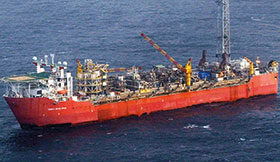

To meet the global demand for oil/gas production, floating production, storage, and offloading (FPSO) vessels have been utilised for a number of years to access deep water deposits. They process oil from subsea wells and store it until it can be offloaded onto waiting tankers or sent through a pipeline to other storage facilities onshore or refineries.
The productivity, flexibility and cost advantages of FPSO vessels have made them increasingly popular within the oil and gas industry. They continue to grow in number and are in use in many of the world’s major offshore production fields.
FPSO vessels can be newly constructed, retrofitted from a decommissioned oil tanker or other vessel, or an existing FPSO can be reworked for redeployment. They are usually connected by mooring buoy and accumulate oil until there is a sufficient amount to fill a transport tanker, at which point the transport tanker connects to the stern of the floating storage unit and offloads the oil.
Liquid and gas flow meters play an important role in FPSO vessel operations by measuring hydrocarbons, water and gas at multiple points in the process.
FPSO flowmeter applications and challenges
There are multiple applications on FPSO vessels for flowmeters, which the industry classifies as top-side instrumentation. The topsides environment aboard FPSO vessels includes many flowmeter applications involving liquid, steam and gas during the separation process.
In addition to normal considerations for selecting a flowmeter such as accuracy and repeatability, FPSO vessel builders and operators are highly space constrained. There is only so much shipboard real estate available for vessel equipment. When equipment such as flowmeters need long pipe upstream/downstream straight runs to condition the fluid for accurate measurement, the required space for straight pipe runs and their substantial extra weight adds unnecessary complications.
In order to obtain the required space for straight pipe runs, vessel builders must juggle moving other equipment to accommodate the additional piping. This usually leads to a domino effect whereby other pieces of equipment must be rearranged as well. This rearrangement compounds over and over creating complicated layouts not to mention the additional weight and space of extra piping. The added weight required by additional piping and complex layouts further complicates other considerations such as transportation and installation. Transportation costs increase dynamically and logistics become more rigorous.
The solution
The ability to eliminate long required straight pipe runs for flowmeter technologies while meeting necessary technical specifications reduces installation real estate and allows for flexible layouts while cutting overall pipe weight, material and installation costs. McCrometer’s uniquely designed differential pressure V-Cone flowmeter is now frequently utilised by the industry’s major FPSO vessel builders and operators.
The V-Cone utilises a centrally located intrusion that redirects the flow to the outside of the pipe and conditions the flow by reshaping the velocity profile, all but eliminating the need for straight pipe runs.
The meters require straight pipe runs of only 0 to 3 pipe diameters upstream and 0 to 1 pipe diameters downstream. This smaller footprint, requiring up to 70% less straight pipe without being affected by flow disturbing equipment up or down stream, is more compact than any other differential pressure meter suitable for subsea use. This allows manufacturers to place the flowmeter exactly where it’s needed without the costly addition of extra pipe and complicated space consuming layouts.
The V-Cone measures fluid flow by utilising the conservation of energy theory, which basically states that in a closed system, energy can be neither gained nor lost. With this in mind we can utilise the PV=nRT equation where pressure multiplied by volume equals temperature while n and R are constants: therefore, imposing a volume change within the pipe line results in a differential pressure drop that can be measured directly.
The results
FPSO vessel applications require what McCrometer’s V-Cone flowmeter has to offer: stable operation at internal pressures up to ANSI 1050 bar, no moving parts, no wear along the beta edge or pipe resulting in no need for physical calibration, high accuracy and repeatability over a long life, and small weight and space footprint. The V-Cone range supports line sizes from 12 to 3000 mm with most types of end connections, can be manufactured out of almost any material and to almost any pressure rating.
For more information contact Stuart Brown, UIC Instrumentation, +27 (0)31 468 2561, [email protected], www.uic.co.za
| Tel: | +27 31 468 2561 |
| Fax: | +27 31 468 8176 |
| Email: | [email protected] |
| www: | |
| Articles: | More information and articles about UIC Control & Automation |
© Technews Publishing (Pty) Ltd | All Rights Reserved